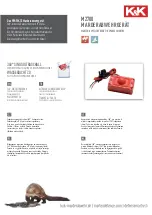
8
FG7B CONTROLLER
:
Programming the FG7B
Note 1:
1.
IO Card addresses are to start at #33 and must be sequential.
2.
Removing a jumper increments the address by the number screen-printed on the pcb.
This address is added to an offset of 33. Example 1. If none of the 16/8/4/2/1 jumpers
are removed then the card will have a net address of 33. Example 2. If jumper 1 of the
16/8/4/2/1 jumpers is removed then the IO card will have a net address of 34. Example
3. If jumper 2 of the 16/8/4/2/1 jumpers is removed then the IO card will have a net
address of 35 etc.
Note 2:
The FG7 scans through the network address at a rate of twenty addresses per second.
The fewer the addresses utilised on the system, the faster the system response. Because
an energizer only updates its own parameters once a second, there is little point in
updating the FG7 display faster than that. A combination of twenty addresses on a FG7
network bus gives the optimal performance in terms of speed versus hardware utilization.
The number of IO Cards used on the system can vary from zero to a maximum of 31.
More than one energizer can be mapped to a single IO card. Example. One IO Card can
be mapped to 19 Energizers. A Fence 1 alarm, from any energizer, can be mapped to one
of the five relays on the IO card. This is useful for electrical contactors and lighting etc.
Only five conditions per energizer can be mapped to a relay. (Use computer network to
get full access to all the information.)
Only the Installer can manually toggle the relay outputs.
Содержание FG7B
Страница 19: ...19 End of document ...





































